2024 Total Solar Eclipse – One in a Lifetime Event You Don’t Want To Miss
18th Feb 2024
A total solar eclipse of the sun is probably one of the greatest things that you can see with your own eyes. Some cities will be lucky to witness it this year. In this guide, we’ll walk you through what a total solar eclipse is, where and how you see it, what you need to bring to maximize your experience, and what you can expect to see along each stage of the total solar eclipse.
What Is a 2024 Total Solar Eclipse?
Simply put, a total solar eclipse of the sun happens when the Moon passes between the Earth and the Sun, blocking out the Sun’s light for a brief period. This creates a spectacular event where the daytime sky goes dark, and the Sun’s outer atmosphere, called the solar corona, becomes visible. The Moon perfectly covers the Sun, casting a shadow on Earth and allowing us to witness this celestial phenomenon.
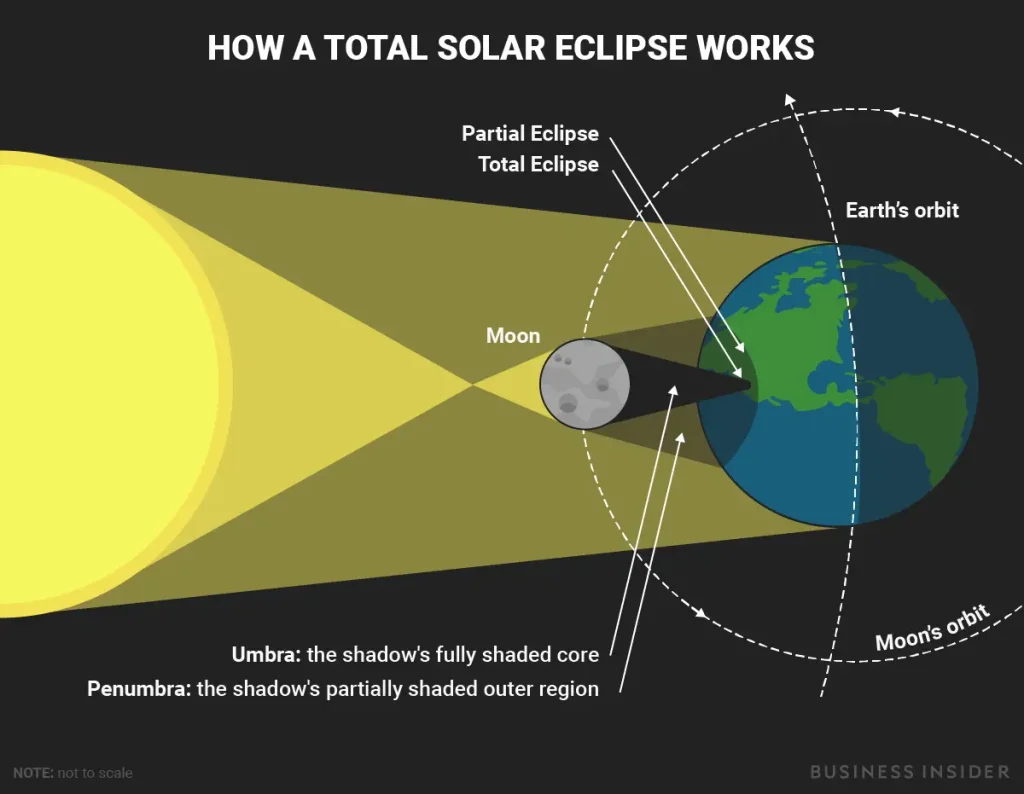
The Sun is about 400 times larger than the Moon, but it is also approximately 400 times farther away. This coincidence in size and distance means that from our perspective on Earth, the Moon and the Sun appear to be almost the same size in the sky.
During totality, observers on Earth can see the Sun’s corona, a region of plasma extending millions of kilometers into space. Scientists use these rare opportunities to study the corona and gather information about the Sun’s outer atmosphere, helping us better understand solar processes.
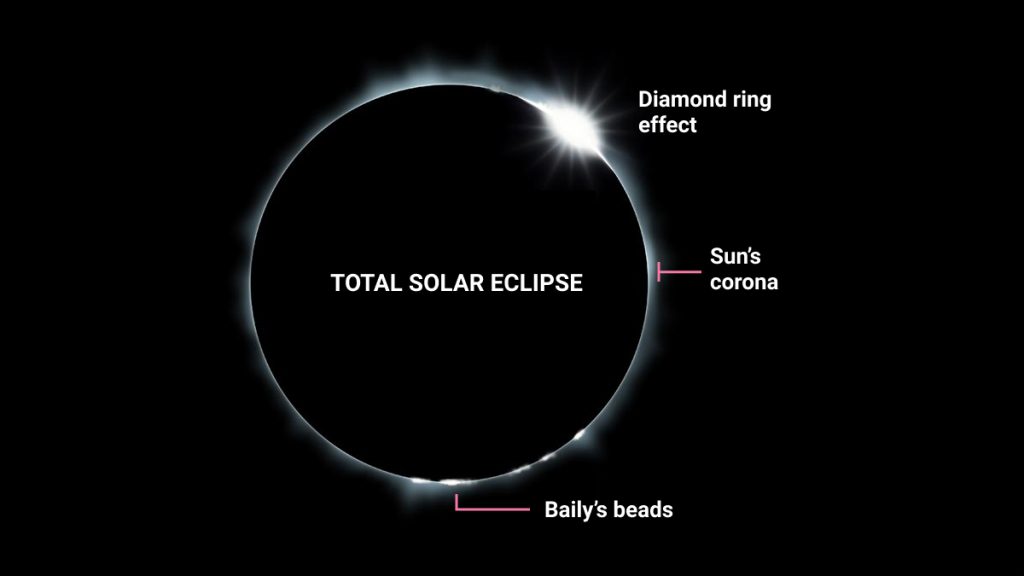
Several cities and towns will go into complete darkness during the day for a few minutes. Typically, a total solar eclipse is visible once roughly every 18 months or once every one to two years from somewhere on Earth, but for a given location, this can be a very rare occurrence coming after a gap of centuries.
What happens in a solar eclipse?
An eclipse is a broad term used to describe the moment when any celestial object, be it a moon or a planet, passes through the shadow of another body, leading to a temporary concealment. In the case of a solar eclipse, the moon positions itself between the sun and Earth, casting its shadow upon our planet.
Solar eclipses come in various forms. A total eclipse unfolds when the moon entirely obscures the sun’s disk. A partial eclipse occurs when only a section of the sun is blocked by the moon. An annular eclipse takes place when the moon moves in front of the sun, creating a visible ring as it doesn’t fully cover the sun from Earth’s viewpoint. There’s also the exceptionally rare hybrid eclipse, a captivating blend of total and annular eclipses.
Among these, the total solar eclipse stands out as the singular occasion when you can safely direct your gaze toward the sun without special glasses, thanks to the moon blocking direct sunlight. During this phenomenon, observers catch a glimpse of the sun’s outermost layer, the corona, typically hidden by the sun’s brilliant face. The corona manifests as white streamers, representing plumes of ionized gas (plasma) escaping into the vastness of space.
If you want to see the total solar eclipse, the first things to consider are the weather and the location from which you view it. Let’s figure this out.
When & Where Can I See Total Solar Eclipse in 2024?
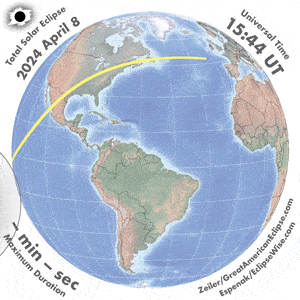
Save the date – 8th of April 2024. On this day, the eclipse is set to journey from northern Mexico, cutting across Texas, New England, and reaching the North Atlantic, traversing through numerous significant population centers. The moon’s shadow, referred to as the path of totality, will directly envelop cities in at least a dozen U.S. states. Spanning approximately 100 miles in width, this path promises a captivating spectacle for observers within its reach.
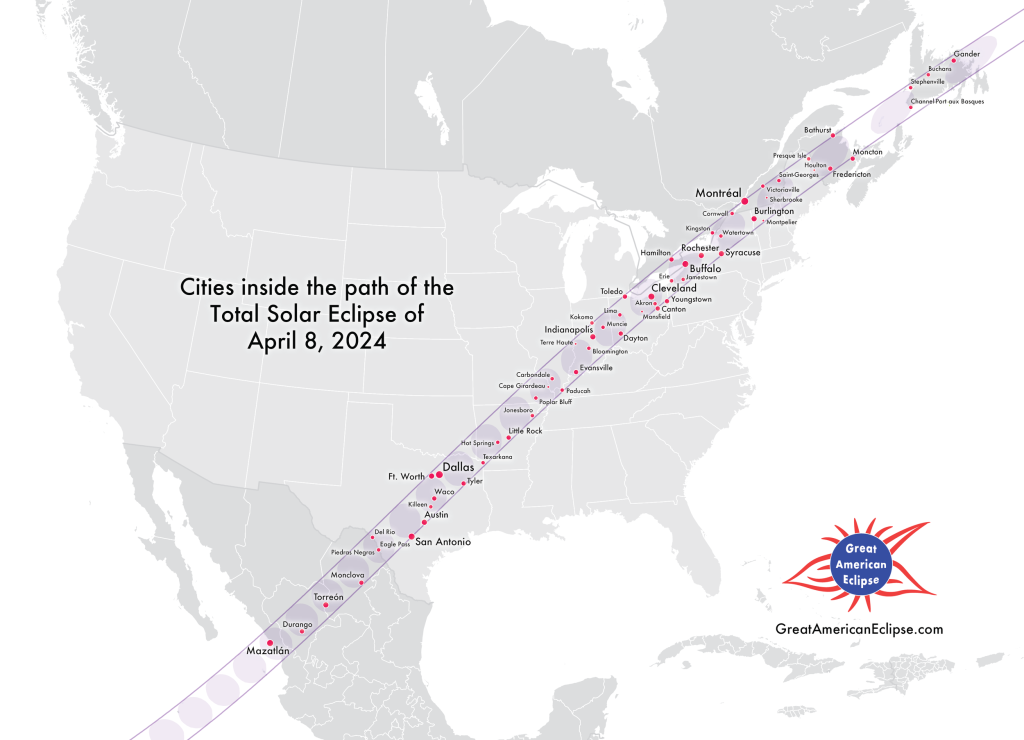
In the animated GIT, the inner black circle, referred to as the umbra, symbolizes the complete shadow, resulting in a total eclipse of the Sun. The outer circle, known as the penumbra, indicates the extent of the partial eclipse. Anticipate a subtle effect near the outer circle and a more pronounced impact near the path of totality. During a significant partial eclipse, the sky undergoes a cooling effect, and sunlight acquires a surreal quality. We highly recommend situating yourself within the path of totality because 99% isn’t equivalent to 100%. To truly witness the corona, you need the complete 100% eclipse experience – positioning yourself right within the path of totality.
Best Location for Total Solar Eclipse
Use this table to find your best location for nature’s greatest sight, what time the greatest eclipse is, the degree of partial eclipse outside the path of totality, and the major cities of North America.

Where is the best place to view the total solar eclipse 2024?
- Cities in Mexico: The eclipse will start in Mexico and then move northeast. Cities like Mazatlán and Durango in Mexico will experience totality.
- United States: The path of totality will extend through several states in the U.S. Some notable locations include:
- Texas: Cities like San Antonio and Austin will experience partial phases, but the path of totality covers areas like Del Rio and Lufkin.
- Midwest: The eclipse path continues through parts of Illinois, Missouri, Kentucky, Tennessee, and Arkansas.
- Northeast: Cities like Buffalo, Rochester, and Syracuse in New York will experience totality.
- Canada: While not in the path of totality, parts of eastern Canada, such as Ontario and Quebec, will experience a partial solar eclipse.
What Is Special About the 2024 Solar Eclipse?
There are no two eclipses alike. You may remember a total solar eclipse sweeping across the US in 2017. But how rare is the 2024 eclipse? For North Americans, this upcoming event is a golden opportunity, as it could be one of the most accessible total solar eclipses in their lifetimes. it marks the final total solar eclipse visible from the contiguous United States until 2044. And there’s more – depending on your location, totality might linger twice as long as it did in 2017, making it the lengthiest totality on land in over a decade!
Adding to the excitement, this total solar eclipse coincides with a period of heightened solar activity. Approximately every 11 years, the sun undergoes a magnetic pole flip, leading to shifts in solar activity. The upcoming eclipse on April 8 aligns with the solar cycle’s expected peak, promising a visually dynamic sun with wisps and streams emanating from its atmosphere. As an added bonus, two planets will grace the celestial stage – Venus shining brightly 15º from the sun even before totality, and Jupiter making a slightly dimmer appearance 30º from the sun during the magical totality. It’s an astronomical spectacle not to be missed!
Where Is the 2024 Solar Eclipse the Longest?
At Mexico’s Pacific coast, 4 minutes 27 seconds of totality is possible. As the moon’s shadow gets larger, the point of longest totality — where viewers could see an eclipsed sun for 4 minutes 28 seconds — will occur at Nazas near Durango, Mexico.
What is the longest-ever recorded time of a solar eclipse?
The longest total solar eclipse of the 21st century occurred on July 22, 2009. The path of totality for this eclipse was exceptionally long, lasting for a maximum duration of about 6 minutes and 39 seconds. The eclipse was visible across a broad path that included parts of India, Nepal, Bangladesh, Bhutan, Myanmar, and China.
Where in Canada will the 2024 solar eclipse be visible?

The total solar eclipse on April 8, 2024, will be visible in several provinces across Canada. The path of totality will pass through the following provinces:
- Newfoundland and Labrador: The easternmost part of the province, including St. John’s, will experience a partial solar eclipse.
- Nova Scotia: Parts of Nova Scotia, including Halifax, will be within the path of totality.
- New Brunswick: The path of totality will cover parts of New Brunswick, offering a view of the total solar eclipse.
- Prince Edward Island: The western part of Prince Edward Island will witness a partial solar eclipse.
- Quebec: The path of totality will pass through some areas in Quebec, including the city of Montreal.
- Ontario: Several regions in Ontario, including Toronto and Ottawa, will experience the total solar eclipse.
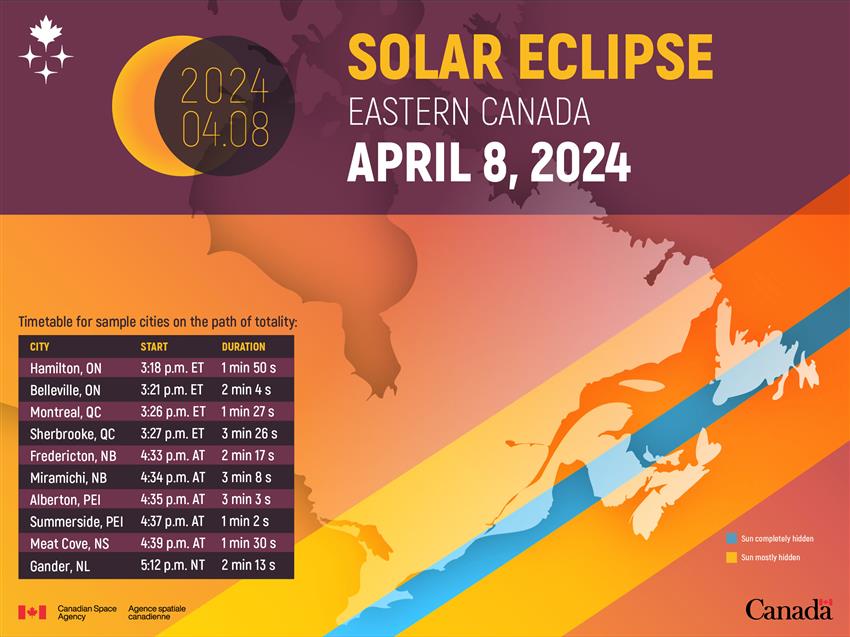
Can You See the Solar Eclipse in the UK in 2024?
Unfortunately, a total eclipse won’t be visible from the United Kingdom. However, according to information from the Royal Museum of Greenwich, residents in the UK will have a chance to observe a partial solar eclipse on April 8, 2024. Over the last 500 years, the UK has experienced only eight total solar eclipses. The most recent total eclipse happened in August 1999, and unfortunately, the next one isn’t expected until September 23, 2090.

Where Can I Observe Partial Eclipse within the UK?
The table below offers information on eclipse visibility and timings (start and end of the partial eclipse) for each component country.
| England | Partial Solar Eclipse | 7:54 pm BST | 8:06 pm BST |
| Northern Ireland | Partial Solar Eclipse | 7:54 pm BST | 8:21 pm IST |
| Scotland | Partial Solar Eclipse | 7:52 pm BST | 8:51 pm BST |
| Wales | Partial Solar Eclipse | 7:55 pm BST | 8:04 pm BST |
Total Solar Eclipse Safety Guide
Here are some clear recommendations for safely exploring the 2024 Total Eclipse with NASA’s guidelines:
- Use Proper Eye Protection:
- Never look directly at the Sun without eclipse glasses or a safe handheld solar viewer, especially during the partial phases.
- Regular sunglasses are not suitable for eye protection.
- Avoid Optical Devices:
- Do not use eclipse glasses or handheld viewers with cameras, binoculars, or telescopes.
- Seek expert advice from an astronomer before using solar filters with optical devices.
- Opt for Indirect Methods:
- Consider indirect methods like pinhole projectors for safe viewing.
- Pinhole projectors project an image of the Sun onto a surface without direct viewing.
- Specific Guidelines for Total Solar Eclipse:
- During the total eclipse, viewers can remove eclipse glasses only during totality.
- Totality is the brief period when the Moon entirely covers the Sun’s bright face.
- Immediate resumption of eye protection is advised as soon as any part of the bright Sun reappears after totality.
Can a Child Watch the Total Solar Eclipse 2024?
Yes, a child can safely watch the total solar eclipse in 2024, but it’s essential to take specific precautions to protect their eyes. Directly looking at the Sun, even during a solar eclipse, can cause serious eye damage. So, apply all the above-mentioned safety tips to ensure a child’s safe viewing experience.
Can I Watch the Eclipse Online?
For sure! If you live outside the states within the path of totality, there are numerous online resources available for you to catch a glimpse. We suggest turning to NASA, whose live feed is conveniently embedded below. NASA will provide two live feeds of the solar eclipse through NASA TV and NASA Edge, streamed across several popular video-streaming services.
![Beauty of the Pink Moon And Lyrid Meteor Shower in This Week’s Best Astrophotos [19-26 April] Beauty of the Pink Moon And Lyrid Meteor Shower in This Week’s Best Astrophotos [19-26 April]](https://orbitaltoday.com/wp-content/uploads/2024/04/Pink-Moon-is-on-its-way-above-the-mountains-1-300x300.jpg)





I visited various websites but the audio quality for auidio
ongs current at this web pazge iss in fact wonderful.